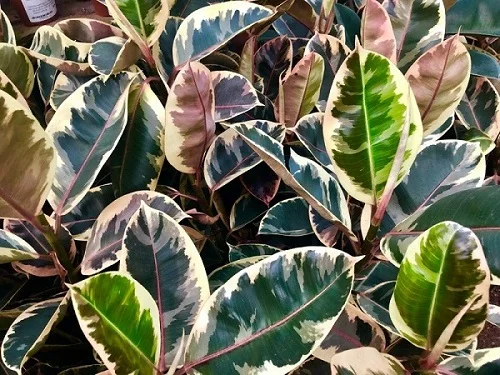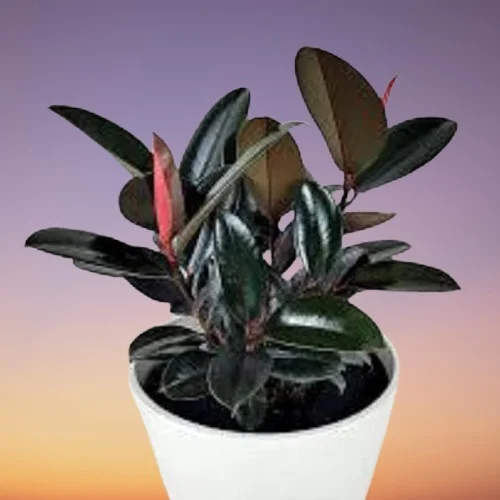Weeping Fig (Ficus benjamina) Indoor Care, Propagation, common Problems & Solutions
Some links in this post may be affiliate links
Ficus benjamina (Weeping Fig) prospers in bright light with 4-6 hours of sunlight, average warmth and humidity, and moderately moist, fertile, well-drained soil coupled with monthly feeding in the growing season.
Ficus benjamina is among the popular Ficus varieties due to its elegant growth and tolerance to poor growing conditions but it does not like sudden changes in light conditions which can lead to excessive leaf fall.
Benjamin Fig bears gracefully drooping branch-lets and glossy leaves, oval with an acuminate tip. The young foliage is light green and slightly wavy, the older leaves are green and smooth. The bark is light gray and smooth but the bark of young branches is brownish.
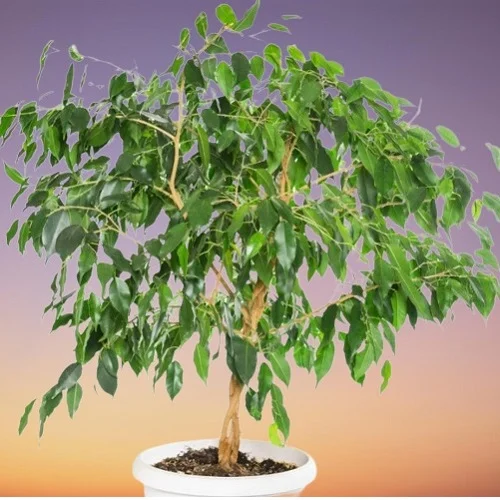
Botanical name: Ficus benjamina
Family: Moraceae
Common name: Weeping Fig, Benjamin Fig, Ficus Tree
Origin
Ficus benjamina is native to Asia and Australia and is among the popular tropical foliage plants ideal for any space. In its native habitat, it produces small fruits favored by some birds like doves and pigeons. The ripe figs are orange-red and are edible.
Size
Weeping Fig can grow to a height of 6 feet when grown indoors but in the natural habitat it grows into a large tree about 20-30 feet tall placing it among the best tree-like plants for the home and other suitable spaces.
Flower
The inflorescences in Weeping Fig are spherical to egg-shaped and shiny green. The inflorescences has three types of flowers; male and fertile and sterile female flowers.
Varieties
There are many varieties of Weeping Fig like Variegata, Starlight, Nuda, Hawaii, Natasha and Gold Princess among others.
Air Cleaning
According to the NASA Clean Air Study, Ficus benjamina was found to be among the best air-cleaning plants effective in cleaning the indoor air of xylene, toulene and trichloroethylene.
Is Ficus benjamina toxic?
Yes. Ficus benjamina is toxic to both humans and pets as indicated by ASPCA. The foliage contains latex which may be of particular concern to latex allergy sufferers. Keep the plant away from latex sensitive persons.
If parts of the Weeping Fig are ingested, it can cause nausea, vomiting, diarrhea and abdominal pains. However, the fruits are edible. Keep it away from children, cats, dogs and other pets to avoid any mishaps.
Where to Buy
If you are looking to acquire Weeping Fig for your collection? You may obtain these plants online from Etsy (Link to Etsy) or from Amazon (Link to Amazon).
How to Care for Ficus benjamina Indoors
To care for Ficus benjamina indoors, provide bright light with 4-6 hours of direct sunlight, warmth of 16-270C, humidity of 50-55% and moderately moist, fertile, well-drained potting mix coupled with monthly feeding in spring and summer.
Weeping Fig requires regular pruning to keep it neat, discourage pests and diseases and also encourage a bushy, compact growth. Repotting is only needed when pot-bound. Keep reading for more on these growing conditions and how to achieve them.
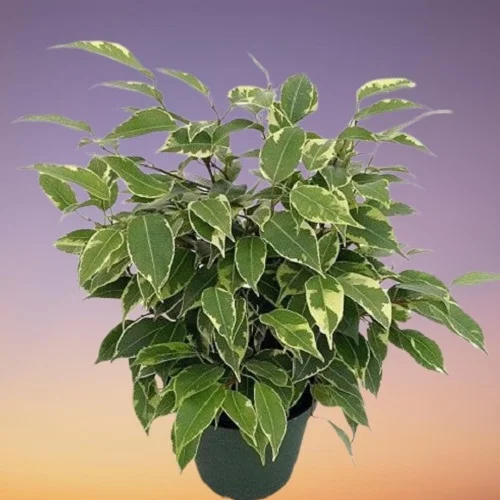
Watering
How often do you water a Ficus benjamina?
Water your Ficus benjamina liberally in spring and summer and allow the top 2-3 inches of soil to dry out between waterings. Keep the soil moderately moist and avoid overwatering to prevent yellowing and leaf drop.
Decrease watering in fall and winter to maintain the soil barely moist as growth is reduced at this time. Do not let the soil dry out completely to avoid wilting, drooping, yellowing and leaf loss.
Use water that is at room temperature to avoid cold shock which can cause reduced growth, yellowing and leaf fall. Only use chlorine-free water like rainwater to prevent browning of leaf edges and tips.
Make sure that soil is free-draining and the pot has a drainage hole to prevent the soil from getting soggy as it can lead to root-rot and death of the plant.
Light Requirements
Do Weeping Figs need sunlight?
Yes. Weeping Figs need bright light with 4-6 hours of morning and late afternoon direct sunshine. Keep them away from hot midday sunshine to prevent scorching.
The plant can adapt to lower light but it will grow much slower. However, the variegated Benjamin Figs require bright light to maintain the variegation.
Ficus Tree is very sensitive to sudden changes in lighting and it may shed all the leaves, therefore avoid moving it to a new location before gradually acclimating it.
If the light is too low, it will lead to stunted growth, yellowing and leaf drop. Where natural light is inadequate, you may use full spectrum grow lights to increase it.
Rotate the pot regularly to ensure that the plant is receiving light on all sides for uniform growth and prevent lopsided growth.
Temperature & Humidity
Ficus benjamina thrives in a warmth of 16-270C. Keep it away from sources of drafts like AC units, heat sources, windy doors and others to prevent sudden changes in temperature which can result in reduced growth, yellowing and leaf drop.
Weeping Fig prefers a humidity of 50-55%; it has no need for extra humidity. However, where the air is too dry especially where temperature is high, it may lead to brown leaf tips and edges.
Therefore, to increase humidity, set the pot on a wet pebble tray, use a cool mist humidifier or group the plants together. Maintain free air flow to minimize fungal diseases.
Fertilizer
Feed your Weeping Fig with a balanced, water-soluble fertilizer monthly in spring and summer to encourage a lush growth. Stop feeding in fall and winter as growth is minimal and feeding at this time can lead to fertilizer burn and eventual death of the plant.
Regularly get rid of excess salts by running a stream of water through the soil until it comes out through the drainage hole. Let the water run for 5-10 minutes to leach out as much salt as possible.
Potting Mix
The best soil for Weeping Fig should be rich in organic matter and free-draining to prevent it from getting soggy while providing the required nutrients. A blend of 2 parts organic potting mix and 1 part perlite (for drainage) is ideal for this plant.
Repotting
Repot your Weeping Fig at the beginning of the growing season (spring to early summer), only when pot-bound. Avoid frequent repotting as it prefers to be pot-bound. Repot only when it has outgrown its current pot; when the roots begin to grow through the drainage holes.
Use a pot 1 size larger and one that has a drainage hole to avoid getting soggy soil as it can lead to root-rot. Use a heavy pot to prevent it from toppling over as the plant can become top-heavy. Check out this ceramic pot with drainage hole and saucer on Amazon.
Never allow the roots of your Benjamin Fig to sit in soggy soil as it may lead to leaf drop and root-rot. Large plants which may be difficult to handle, replenish the top 2-4 inches of soil with fresh soil annually.
Pruning & Maintenance
Pruning Ficus benjamina entails removal of dead and yellow leaves to maintain the plant neat and tidy as well as discourage pest and disease infestations.
When the plant has reached maximum height or it has become leggy, cutback the branches to rejuvenate growth and encourage a bushy growth. The foliage emating from pruning can be used to propagate new plants.
Once in a while clean the leaves by washing them under a steady stream of water from a hose to get rid of dust and discourage pest infestation.
Weeping Fig Propagation
Weeping Fig (Ficus benjamina) is best propagated from stem-tip cuttings at the beginning of the growing season.
Propagating Weeping Fig from stem-tip cuttings
- Take stem-tip cuttings of about 6 inches long from a healthy plant.
- Strip off the lower lower leaves but ensure that the cutting has at least 2 sets of leaves on top.
- Dip the cut end of the cutting in a rooting hormone to enhance rooting.
- Insert the cutting in moist rooting soil. Ensure the rooting container has adequate drainage to avoid getting soggy soil.
- To hasten rooting of the cutting, create a mini-greenhouse by covering the set up with a clear polythene sheet or bag.
- Make sure that the leaves of the cutting do not touch the sheet or bag too much by propping it up with sticks.
- Place the set up in warm, well-lit spot and maintain the soil moist through out until new growth emerges.
- New growth indicates that the cutting has rooted. In about 2-4 weeks, rooting of the cutting will have taken place.
- Gradually over a period of two weeks, remove the plastic bag cover to acclimatize the new plant.
- In 4-6 months, there will be adequate root development and and normal care for the new plant can begin.
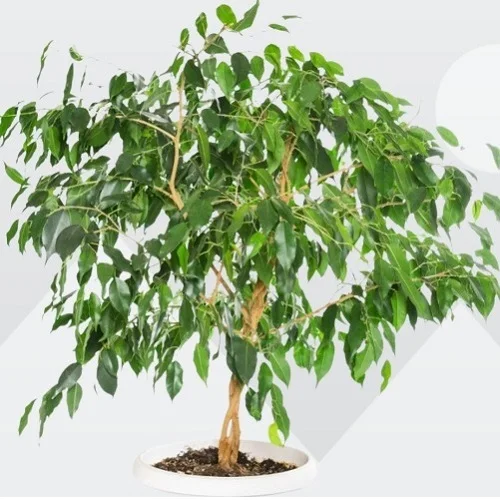
Weeping Fig Problems & Remedies
Weeping Fig commong problems are dropping leaves, yellow leaves, pests and diseases among others. Keep reading for more on these problems and how to fix them.
Dropping leaves
Dropping leaves on Ficus benjamina are caused by insufficient light, inconsistent watering, soggy soil, temperature stress, dry air or salts buildup.
How to fix it
Insufficient light: Move the plant to a brighter spot where it will receive bright light with 4-6 hours of sunlight or instal a grow light if the natural lighting is not adequate.
Inconsistent watering: Water when the top 2-3 inches of soil feel dry but do not allow the soil to dry out completely. Do not water on schedule.
Soggy soil: Ensure that the pot has a drainage hole and the soil is free-draining.
Temperature stress: Keep the plant from drafts emanating from windy doors, drafty windows, AC units, heat sources and others to maintain a warmth of 16-270C.
Dry air: To increase humidity, set the pot on a wet pebble tray, use a cool mist humidifier or group the plants together.
Salts buildup: Regularly get rid of accumulated salts by running a stream of water through the soil until it comes out through the drainage hole. Let it run for 5-10 minutes to remove most of the salts.
Yellow leaves
The main causes of yellow leaves on your Weeping Fig are too little light, soggy soil, inconsistent watering, drafts, nutrients deficiency or aging.
How to fix it
Too little light: Position the plant in medium to bright indirect light or use a grow light if you do not have adequate light in your home.
Soggy soil: Use a free-draining soil and a pot with a drainage hole.
Inconsistent watering: Water when the top 2-3 inches of soil feel dry but do not allow the soil to dry out completely. Do not water on schedule.
Drafts: Keep the plant away from sources of drafts like hot air vents, AC units, hot surfaces, windy doors among others.
Nutrients deficiency: Feed the plant with a balanced, water-soluble fertilizer every 4 weeks in spring and summer.
Aging: This is a natural process. As the plant matures the older leaves turn yellow and drop off.
Pests
Common pests on Weeping Fig are aphids, scale, mealybugs and spider mites which are prevalent in dry air conditions.
How to fix it
- Isolate the affected plant to prevent spread to other plants.
- Treat the infested plant with neem oil or insecticidal soap. Ensure to follow the manufacturers' instructions.
- Regularly check underneath and between the leaves for these pests and carry out timely control measures.
- Keep the plant properly pruned to reduce the hiding places for these pests.
- To minimize the pests infestations, group the plants together or set the pot on a wet pebble tray to raise humidity.
- Maintain good air flow to discourage the pests infestations.
Diseases
Weeping Fig is prone to root-rot disease which is enhanced by soggy soil. It is characterized by wlting, yellowing and browning of the leaves which is rapidly followed by plant collapse.
How to fix it
- Carefully, slip the plant out of its pot and inspect the roots. Brown mushy roots indicate root-rot.
- Cut the brown-black roots and treat the healthy roots with a copper-based fungicidal solution as recommended by the manufacturer.
- Repot the plant in fresh, well-draining soil and keep it dry for some time before resuming watering.
- Ensure that the pot has a drainage hole to prevent the soil from getting soggy.
- Reduce watering in fall and winter as growth is minimal at this time, thus, the plant does not need much water.
You liked it? Share on social media.
Related Content
Amazon Associates Disclosure
Homeplantsguide.com is a participant in the Amazon Services LLC Associates Program, an affiliate advertising program designed to provide a means for sites to earn advertising fees by advertising and linking to amazon.com.




